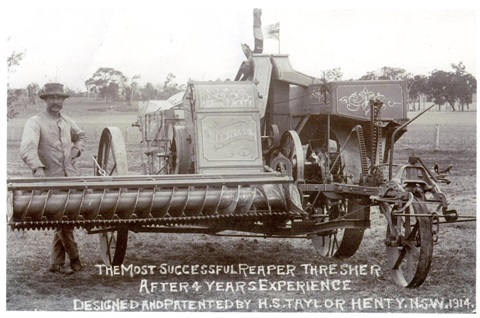Headlie Shipard Taylor

A local Henty farmer’s invention revolutionised the world’s grain industry.
After the First World War, the second Industrial Revolution was in full swing. Advancements in technology enabled the widespread adoption of systems such as the telegraph and the construction of rail networks. This period also saw many innovations in manufacturing and the establishment of the machine tool industry.
Leading the way in Australia was Henty's Headlie Shipard Taylor, a local cereal farmer who had left school at just 14 years of age and set out to create machinery that would harvest damaged crops. His aim was to build a machine that would remove grain by cutting off the head, rather than stripping the grain from the plant, which would make it possible to save crops affected by storms, weeds or wind.
Taylor ordered books from which he taught himself engineering, and made his own tools in a blacksmith’s shop.
After several years and a number of unsuccessful attempts, Taylor finally demonstrated his harvester at the 1914 Henty Agricultural Show. His comb-and-header design could handle tangled and weed-infested wheat crops of any height, enabling grain to be harvested more efficiently.
In 1916, H.V. Mackay agreed to build the header-harvesting machine at his factory in Sunshine, Victoria. Orders flowed in.
By 1920–21, with more than 18,000 farmers growing wheat in New South Wales alone, Taylor’s innovative harvester had completely revolutionised the grain industry across Australia and around the world.
Image: Headline Taylor, c. 1914. ‘The most successful reaper thresher after 4 years’ experience. Designed and patented by H.S. Taylor, Henty.’ Courtesy of Museums Victoria.